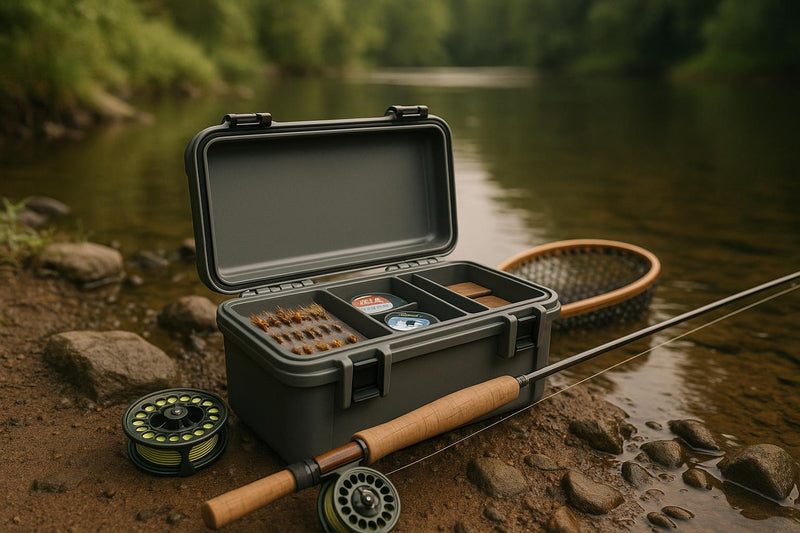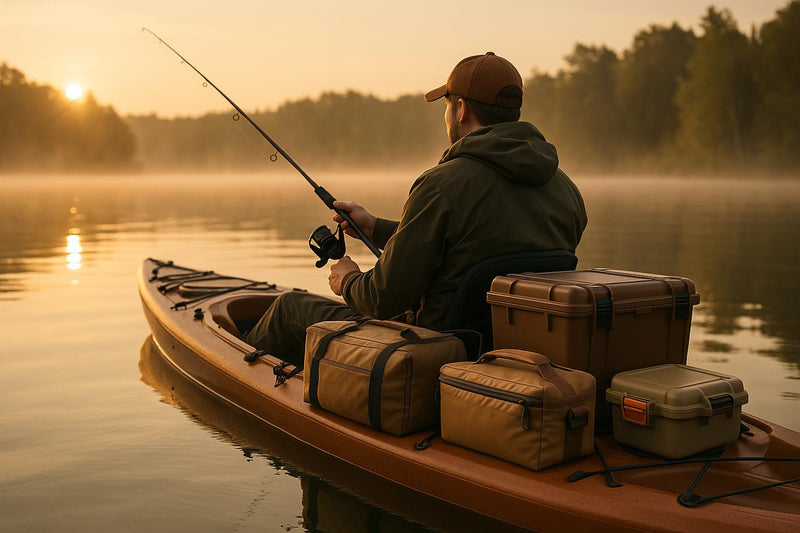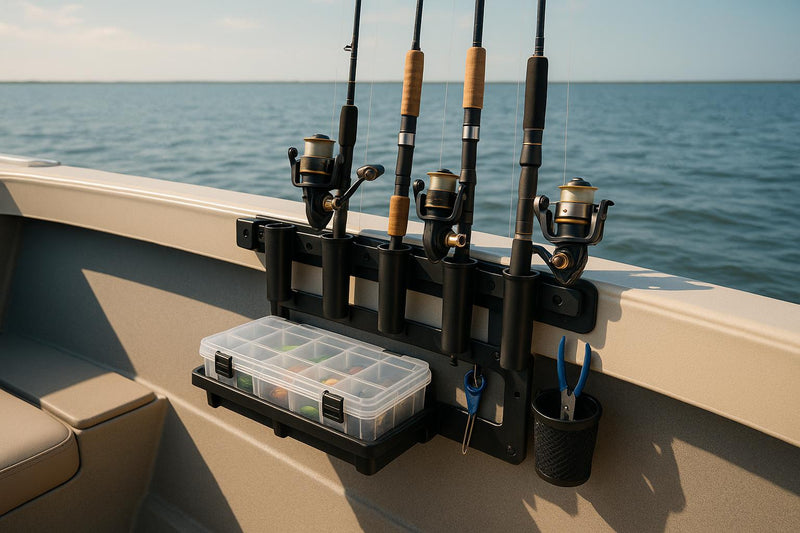Fishing shorts often face tough stains like fish blood, mud, and oil. Acting quickly and using the right cleaning methods is key to keeping them in good condition. Here's how to tackle common stains effectively:
- Fish Blood: Rinse with cold water immediately and use enzymatic cleaners to break down proteins.
- Mud: Rinse fresh stains right away; pre-treat dried mud before washing to avoid damaging the fabric.
- Oil/Grease: Apply dish soap or a degreaser to break down oils before washing.
For best results, use cold water, avoid harsh chemicals, and air-dry to preserve water-resistant coatings. Choose high-quality fishing shorts with stain-resistant materials to simplify maintenance. Proper care ensures your gear lasts longer and performs better on every trip.
Common Fishing Stains Explained
When it comes to fishing, stains are just part of the game. Knowing what you're up against can make all the difference in how you clean and care for your fishing shorts. Each type of stain reacts differently to fabric, so understanding their characteristics is key. Fortunately, modern fishing gear - especially those featuring water-resistant and quick-dry materials - handles stains far better than traditional cotton options.
These advanced fabrics are designed to repel stains. As Nathan Dinsdale explains:
"Purpose-built fishing gear can feature special fabric treatment and construction that allows liquid - like water, blood, and viscera - to bead up and run off rather than soaking into fabric and staining."
This is why investing in high-quality Men's Fishing Shorts with water-resistant coatings is worth it. These treated fabrics act as a barrier, keeping stains from sinking deep into the fibers and making cleanup much easier. Let’s break down how to handle the most common types of fishing stains.
Fish Blood and Organic Stains
Fish blood and slime - especially from species like hardhead catfish or sand trout - can leave behind some of the toughest stains. These protein-based stains bond tightly to fabric if not treated quickly. The trick is to act fast with cold water, as hot water can "cook" the proteins, making the stain permanent. Enzymatic cleaners are particularly effective for breaking down these proteins, and fresh stains may even respond to household hydrogen peroxide.
Water-resistant fabrics give you an edge here by preventing blood from soaking deep into the material. This is especially helpful with padded shorts, where stains can be harder to remove. A quick rinse with cold water followed by enzymatic treatment can save your gear from lasting damage.
Mud and Dirt Stains
Mud and dirt are practically guaranteed when fishing near shorelines, wading in streams, or setting up at a beach. Mud stains are tricky because they’re a mix of organic matter, clay, and minerals, which can discolor fabric. Wet mud can quickly work its way into fabric fibers, and once it dries, it becomes abrasive, potentially damaging the material if scrubbed too harshly. Quick-dry fabrics help by limiting moisture retention, making it harder for mud to settle deeply.
Timing is everything here. Rinse off fresh mud as soon as possible. If it’s already dried, pre-treat the area before washing to loosen the stain without damaging the fabric.
Oil and Grease Stains
Oil and grease stains are another common issue, whether it’s bait oils, boat engine grease, or even sunscreen. These stains are stubborn because oily substances repel water, making them resistant to regular washing. Sunscreen, in particular, can create persistent orange stains, especially when combined with hard water or high iron content.
One forum user shared their frustration:
"Don't even think about getting sunscreen on them - they turn orange in a couple of hours and it’s there forever."
Another user, superknt, pointed out:
"The micro polyester shirts clean up the best because they do not absorb the stain."
To tackle oil stains, act quickly. Use degreasing agents like dish soap or specialized stain removers to break down the oil before it has a chance to oxidize and set. While water-resistant coatings on quality fishing gear offer some protection, oils can still seep through if left untreated. Prompt action with the right cleaning products is crucial to keeping your gear in top shape.
Cleaning Supplies and Setup
Before diving into cleaning your Fishing shorts, it’s smart to gather all the necessary supplies. This not only saves time but also ensures you’re taking proper care of specialized features like removable thigh pads and water-resistant coatings.
Household Cleaning Items
Sometimes, the best tools for stain removal are already in your home. For grease or oil stains, a small amount of liquid dish detergent can work wonders. Gently rub it into the stain, let it sit for about 15 minutes, and then wash as usual.
For fish blood or other organic stains, mix baking soda with water to create a paste. Apply it directly to the stain or, for fresh oil spills, sprinkle baking soda on the area to absorb the grease. If the stain is particularly stubborn, a 3% hydrogen peroxide solution can help break down protein-based residues like fish blood.
Keep clean white towels or paper towels handy for blotting stains and absorbing cleaning solutions. Even something as simple as bar soap can be effective - just wet the soap and rub it directly onto fresh blood stains for quick treatment.
For tougher biological stains like fish slime or blood, enzyme-based laundry detergents such as Tide or Persil are excellent options. These detergents contain proteins that target and break down organic matter, making them a reliable choice for fishing gear.
Specialized Products for Fishing Stains
When household items don’t cut it, specialized products designed for fishing-related stains can step in. Look for detergents and stain removers with concentrated enzymes and surfactants to tackle fish oils, bait residue, and salt deposits. Always follow the instructions on the product to avoid harming the fabric of your Fishing shorts.
Before You Start Cleaning
Before cleaning, take a few precautionary steps to protect your gear:
- Check the care label: These labels provide essential instructions tailored to your shorts' fabric and construction. For features like water-resistant coatings or removable padding, following the manufacturer’s guidelines helps prevent issues like shrinkage or discoloration.
- Pre-rinse with cold water: This helps loosen stains before applying any cleaner.
- Test the cleaner: Always test cleaning solutions on a hidden area to ensure they don’t damage the fabric.
- Remove detachable components: Take out any removable parts, like thigh pads, so they can be cleaned separately. Some padding materials may require hand washing instead of machine cleaning.
For padded shorts, double-check whether the padding is safe for machine washing or if it needs special care. Ignoring these steps can lead to damage, void warranties, or even force costly replacements.
Finally, work in a well-ventilated area when using strong cleaners, and store your cleaning supplies away from direct sunlight to maintain their effectiveness. By taking these precautions, you’ll preserve the water-resistant and quick-dry properties that make your Mens Fishing Shorts a reliable choice for your adventures.
How to Remove Stains Step by Step
Got a stain on your Fishing shorts? Don’t worry - acting quickly can make all the difference. Follow this step-by-step guide to tackle stains effectively. Early pre-treatment is key to better results.
Pre-treating the Stain
Start by rinsing the stain with cold water as soon as possible - even if you’re still out on the water. This helps stop the stain from setting. Use a clean white cloth to blot the stain, working from the edges toward the center. Avoid rubbing, as this can push the stain deeper into the fabric and cause it to spread.
If you’re dealing with fresh blood stains from handling fish, run cold water through the fabric from the inside out. This forces the stain out instead of embedding it further into the material. This method is especially important for Mens Fishing Shorts with water-resistant coatings.
Once the stain is loosened, you’re ready to apply a cleaning solution.
Applying the Cleaning Solution
Choose your cleaning solution based on the type of stain. For grease or oil stains, apply original blue Dawn dish soap directly to the area. Work the soap into the fabric with your fingers to create a good lather before moving on to the next step.
If the stain is organic, like fish blood or slime, use an enzyme-based detergent. Apply it to both sides of the fabric and gently rub it in from the back to help the cleaner penetrate the fibers.
For tougher, set-in stains, mix a solution of one part cold water and two parts white vinegar. Soak the stained area for about 30 minutes before washing. Always check the care label first, especially if your shorts have delicate fabrics or special coatings.
Soaking, Washing, and Drying
After pre-treating and applying the cleaning solution, it’s time to soak and wash. Soak the shorts in cold water for 30–120 minutes, depending on how stubborn the stain is. Adding a scoop of enzyme detergent to the water can give you extra cleaning power.
When washing, stick to the care label’s temperature recommendations. Most quick-dry fabrics perform best in cold or warm water. Use your regular detergent but skip the fabric softeners - they can interfere with the fabric’s moisture-wicking abilities.
Avoid using high heat during drying, as it can permanently set stains. Instead, air-dry your shorts in a well-ventilated area. Once they’re fully dry, examine them under bright light. If any stain remains, repeat the pre-treatment and washing steps.
If your shorts have removable thigh pads, wash those separately, following their specific care instructions. Some padding materials need gentle hand washing to preserve their shape and cushioning. Knowing the key differences between padded and regular shorts can help you care for each part properly.
Keep in mind that water-resistant treatments can be sensitive to harsh chemicals and high temperatures. By following these stain removal techniques, you’ll not only keep your shorts clean but also preserve the features that make them perfect for fishing adventures.
sbb-itb-cb0a783
How to Prevent and Manage Stains
Tackling stains on fishing gear starts with quick action after every trip.
Rinse After Each Trip
Right after your fishing trip, rinse your Fishing shorts with fresh, cold water. This helps wash away fish slime, blood, mud, and salt before they have a chance to settle in [13, 17, 19].
Turn your shorts inside out to protect the outer surface and to better remove any dirt or grime trapped in the fabric. Pay extra attention to areas prone to stains, like the thighs and pockets, where bait residue tends to build up.
If your shorts are caked in mud, it's a good idea to pre-soak them in cold water for 15–30 minutes before rinsing. Once rinsed, let them air dry naturally. Using high heat can lock in stains and odors, and it might even damage or shrink the fabric over time [13, 17, 18, 19].
Separate Heavily Soiled Items
Avoid washing heavily stained fishing gear with your regular laundry. Morgan LaLonde, Laundry Brand Manager for Whirlpool, emphasizes the importance of this:
"This prevents dirt and stains from transferring to other garments."
By separating soiled gear, you can use longer wash cycles and more detergent, ensuring a deeper clean without risking your other clothes. This also helps avoid spreading bacteria, fungi, or allergens that may come from fish blood, bait residue, or pond water [21, 22].
For the best results, pre-treat visible stains based on their type before washing. A longer cycle gives the detergent more time to break down stubborn grime.
Choose Stain-Resistant Gear
Opt for high-quality Fishing shorts designed with stain-resistant and quick-dry fabrics. These materials repel liquids more effectively than standard fabrics, making it easier to wipe away stains before they set.
Quick-dry technology not only speeds up drying time but also minimizes the window for stains to become permanent. Plus, padded fishing shorts with removable thigh pads add another layer of convenience. You can clean these pads separately, ensuring they get the care they need while protecting the rest of the garment. This is one of the key differences between padded and regular shorts that simplifies maintenance.
Features like deep hand pockets and zippered compartments also play a role in stain prevention. By securely storing bait, tools, and other messy items, these designs help keep grime off your shorts.
Up next, discover the best practices for washing, drying, and storing your premium padded fishing shorts.
Caring for Premium Padded Fishing Shorts
Premium fishing shorts with removable thigh pads and a quick-dry, water-resistant finish are built for comfort and durability, making them a must-have for every fishing trip. To keep them performing their best, proper care is key. From washing to storage, these tips will help extend the life of your gear.
Washing and Drying Tips
- Take out the thigh pads before washing: This is a critical step to avoid damage. The pads are designed to be easily removed and stored flat, ensuring they stay in good shape during cleaning.
- Use a gentle cycle with cold water: Stick to mild detergent and skip bleach, fabric softeners, or any harsh chemicals. These can weaken the quick-dry and water-resistant properties of the fabric.
- Air dry or tumble dry on low heat: High heat can harm the water-resistant finish and compromise the fabric's durability. Hang drying is often the safest option.
Storing Your Shorts
Once your shorts are clean, storing them correctly is just as important.
- Keep them in a cool, dry, and ventilated space to avoid moisture damage or odors.
- Store the removable thigh pads flat to maintain their shape and functionality.
Conclusion
Keeping your fishing shorts clean doesn't have to be a hassle if you know the right steps. Quick action is your best ally - rinsing or blotting stains immediately, even with lake water, can stop organic stains like fish blood from settling into the fabric.
For the best results, pair the right products with the right methods. Hydrogen peroxide works wonders on blood stains, while a mix of hydrogen peroxide, Dawn dish soap, and baking soda tackles stubborn grease marks. Remember to spot-test any cleaning solution on darker fabrics to avoid fading. Be gentle - scrubbing too hard can harm the fabric's fibers. Stick to proper washing and drying techniques to keep your shorts in top shape. Once you've nailed down your cleaning routine, it's time to think about investing in gear that's built to last.
Choosing high-quality fishing shorts made with stain-resistant materials can make maintenance a breeze. Premium shorts not only offer better stain resistance, but their ergonomic designs ensure all-day comfort during long fishing trips. Plus, durable materials mean fewer replacements over time.
Take your fishing game to the next level with gear designed to perform. Check out the full collection of Men's Fishing Shorts at Reel Comfort, where premium materials and angler-focused designs come together to support every adventure.
FAQs
How can I remove stains from fishing shorts without damaging the water-resistant coating?
To clean fishing shorts without compromising their water-resistant coating, start by using cold water and a mild detergent specifically designed for technical fabrics. Steer clear of fabric softeners, bleach, or any harsh chemicals, as these can damage the coating and reduce performance. For tougher stains, gently scrub the affected area with a soft sponge or brush and a bit of mild soap, then rinse thoroughly to remove all residue.
Once cleaned, either air dry the shorts or use a tumble dryer on a low heat setting. This careful approach helps preserve the water resistance and durability of your fishing shorts, keeping them ready for your next adventure.
How can I stop fishing stains from setting while I’m still out on the water?
To keep stains like fish blood, bait, or mud from setting while you're out fishing, it’s important to act fast. Start by rinsing the stained area with cold water as soon as you can - avoid hot water, as it can make the stain tougher to remove. If you don’t have water handy, use a damp cloth or wet wipe to gently blot the stain. This will help minimize how much the stain is absorbed.
For more stubborn stains, like fish blood, try applying a small amount of dish soap or a mild detergent directly to the spot. Once you have access to water, rinse it out with cold water. Another tip? Wearing quick-dry fishing shorts made with moisture-wicking fabric, such as those from Reel Comfort, can make a big difference. These fabrics help reduce sweat and moisture buildup, making it harder for stains to set during your trip.
What fabrics are best for resisting stains on fishing shorts, and what features should I look for when buying them?
Fabrics such as nylon and polyester are solid options for fishing shorts. They’re tough, resist water, and are a breeze to clean. These materials can handle the usual messes from fishing - think fish blood, bait, or mud - while also withstanding saltwater and frequent washing without breaking down.
When picking out fishing shorts, prioritize features like quick-dry materials, ripstop construction for extra toughness, and stain-resistant coatings. These details help keep your shorts looking good and lasting longer, even on long fishing adventures. Functional touches like ample storage pockets and ergonomic designs can also make your time on the water more comfortable and practical.




